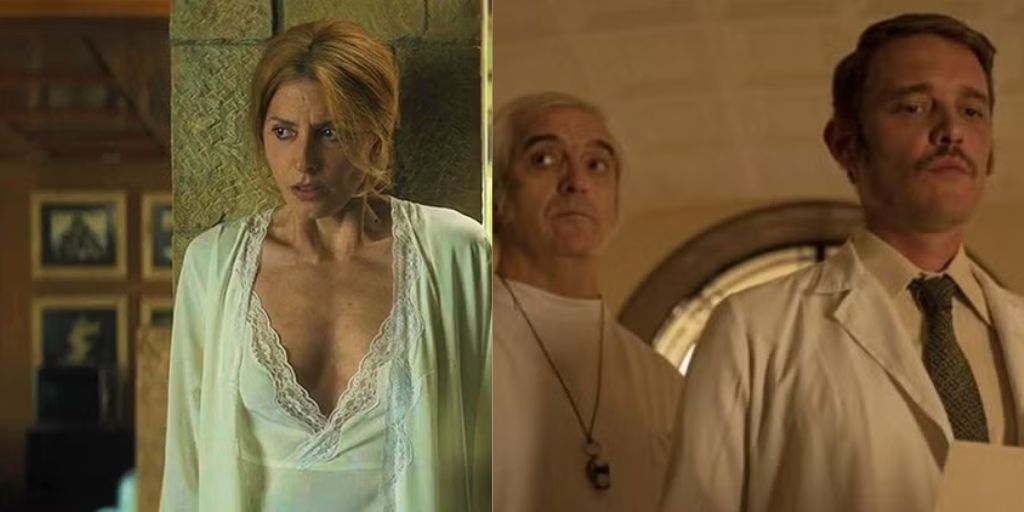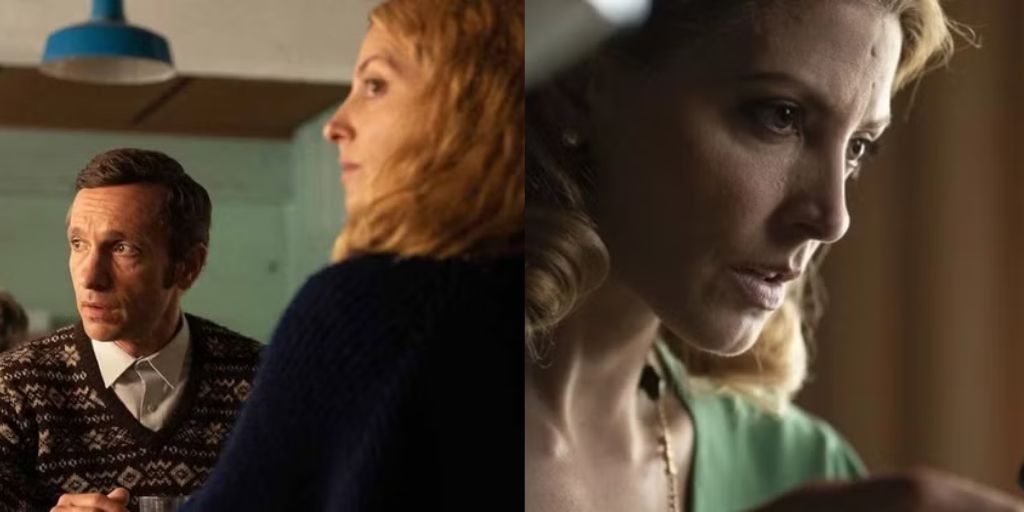Only a few movies can successfully play with ideas of perception and reality. God’s Crooked Lines is one of those films that not only captures these themes but also delivers an engaging story that keeps viewers on the edge of their seats.
With its mind-bending narrative and intense atmosphere, this film leaves a lasting impression. Directed by Oriol Paulo, known for his talent in creating suspenseful stories, God’s Crooked Lines unfolds in a 1970s psychiatric hospital, where tension and paranoia reign supreme.
The Plot Unfolds: A Disturbing Investigation
The story centers on Alice (played by Barbara Lennie), a private investigator who goes undercover as a patient at a mental health facility to look into a suspicious death.
This intriguing setup immediately captures the audience’s attention. Alice is determined to uncover the truth behind the mysterious circumstances surrounding the death, but her journey becomes much more complicated than a simple murder investigation.
When Alice enters Our Lady of the Fountains Hospital, she finds herself surrounded by uncertainty and fear. The atmosphere is thick with tension, and it is clear that the hospital is not a typical mental health facility.
From the very beginning, viewers sense that something is deeply wrong. The unsettling environment serves as a backdrop for Alice’s investigation, and her efforts to blend in as a patient become increasingly dangerous as the story progresses.
As Alice interacts with the other patients and the hospital staff, the lines between reality and illusion begin to blur. She starts to question her own perception of what is happening around her.
The plot unfolds in a way that challenges the audience to keep up with the twists and turns, making it difficult to predict what will happen next. This uncertainty keeps viewers engaged and wanting to know more.
An Atmosphere of Paranoia and Uncertainty
The film effectively creates an atmosphere of paranoia and uncertainty, making viewers feel as if they are part of Alice’s experience. The hospital’s eerie setting, combined with the mysterious characters, adds to the feeling of dread.
Each scene is filled with subtle hints that something is not quite right, leaving audiences guessing and on edge. The direction by Oriol Paulo plays a crucial role in establishing this mood.

Paulo expertly uses visual storytelling to convey the psychological tension within the hospital. Shadows loom large, and the camera often lingers on characters’ expressions, capturing their fear and confusion. This visual style enhances the full experience, drawing viewers into the story and making them feel the weight of Alice’s struggles.
One of the film’s strengths is its ability to plant tiny clues and visual details that make viewers question everything they see. For example, in one scene, Alice has a lunch meeting with Dr. Donadio (played by Lluís Soler).
While they seem to have an ordinary conversation, the food and drinks on the table mysteriously disappear. This subtle detail raises questions about Alice’s perception of reality and hints at the mental games being played around her.
Characters and Their Dualities
The characters in God’s Crooked Lines are complex and multi-dimensional, contributing to the film’s sense of unease. Friends turn into foes, and motives seem to shift constantly. This makes it hard for Alice—and the audience—to know who to trust. The film’s portrayal of these characters adds depth to the narrative.
Dr. Alvar (Eduard Fernández) is one character who embodies this complexity. At first, he appears to be a trustworthy figure, but as Alice learns more about him, he becomes increasingly suspicious.
The revelation that Alice’s husband gave Dr. Alvar a large check adds layers of doubt not only to him but also to the entire medical team. As Alice uncovers more information, the trustworthiness of those around her is called into question.
Similarly, Alice’s husband seems like a caring partner, but once it is revealed that he took her fortune, the audience’s perception of him shifts dramatically.
This twist complicates Alice’s already precarious situation and deepens the themes of betrayal and mistrust. Just when viewers believe they have figured out who is in the right, new information surfaces, forcing them to reconsider everything.
This constant shifting of trust creates a mental maze for both Alice and the audience. Each new revelation adds to the suspense, as viewers must face the tangled web of relationships and motives. The film masterfully keeps the audience guessing about the truth, making it difficult to settle on a definitive answer.
Bárbara Lennie’s Attractive Performance
At the heart of God’s Crooked Lines is Bárbara Lennie’s outstanding performance as Alice. Lennie brings a unique blend of vulnerability and strength to her character, making her portrayal both engaging and relatable. From the moment she steps into the hospital, there is a quiet intensity about her that keeps viewers invested in her journey.

Lennie skillfully captures the complexities of Alice’s character. She conveys a sense of fragility that allows audiences to empathize with her struggles. However, as the story progresses, Lennie also reveals Alice’s resilience and determination to uncover the truth. This duality is crucial to the film’s narrative, as it mirrors the themes of trust and deception present throughout.
One of the most striking aspects of Lennie’s performance is her ability to convey Alice’s growing self-doubt. Rather than making it obvious, she gradually allows cracks to appear in Alice’s confidence.
This nuanced approach adds depth to the character and enhances the tension within the film. As viewers witness Alice’s mental state deteriorate, they cannot help but question her reliability.
For instance, in a tense moment when Dr. Alvar confronts Alice about her motives for checking into the hospital, Lennie delivers her lines with a calm yet icy demeanor. However, there is a flicker of uncertainty in her eyes that reveals her internal struggle. This subtle acting choice illustrates the character’s fragility and keeps viewers guessing about her true intentions.
The Role of Memory and Perception
God’s Crooked Lines goes into the complex relationship between memory and perception. As Alice investigates the suspicious death, she must confront her own memories and question their accuracy. The film poses important questions about the reliability of memory and how it can be influenced by external factors.
Throughout the story, Alice’s recollections become increasingly muddled. She struggles to piece together the events surrounding the death she is investigating, leading her to doubt her own mind. This theme resonates with audiences, as it reflects the real-life challenges many individuals face in processing their memories.
The film also shows how perception can be manipulated. As Alice shows the hospital, she encounters various characters who may have their own agendas. The tension between what is real and what is a construct of her mind creates a attractive narrative that keeps viewers engaged. Each interaction raises further questions about trust and authenticity.
One of the film’s most compelling elements is how it portrays the psychological impact of being in an environment where trust is scarce. Alice’s mental state deteriorates as she grapples with her perception of reality. This emotional turmoil adds depth to her character and makes her journey even more gripping.
Cinematic Techniques and Storytelling
The film employs various cinematic techniques to enhance its storytelling. Paulo uses lighting, sound design, and camera angles to create a sense of unease. The dimly lit corridors of the hospital, the haunting score, and the close-ups on characters’ faces all contribute to the full atmosphere of paranoia.
Lighting plays a crucial role in shaping the mood of the film. Dark shadows and stark contrasts create a sense of foreboding, reflecting the uncertainty that permeates the story. The careful use of light and shadow helps to establish the film’s psychological tension and keeps viewers on edge.
Sound design also adds to the film’s unsettling nature. The haunting score complements the visuals, heightening the emotional impact of key scenes. Subtle sound effects, such as echoes or whispers, enhance the feeling of being trapped in the hospital, intensifying the sense of isolation that Alice experiences.
Camera angles and framing choices further enhance the storytelling. Paulo often uses close-ups to capture the characters’ emotions, allowing audiences to connect with their experiences.
The use of wide shots in certain scenes emphasizes the vastness of the hospital, creating a feeling of entrapment. These visual choices work together to immerse viewers in Alice’s world and heighten the suspense.
Themes of Trust and Betrayal
God’s Crooked Lines shows profound themes of trust and betrayal. As Alice faces the complex relationships within the hospital, she must constantly reassess whom she can trust. The film raises important questions about loyalty and the nature of human connections.
Alice’s journey is marked by a series of betrayals that challenge her understanding of those around her. The shifting loyalties and hidden agendas create an atmosphere of mistrust, making it difficult for her to determine who is truly on her side. This theme resonates with audiences, as it reflects real-life experiences of betrayal and deception.
The scheme of trust extends beyond Alice’s relationships with others. As the plot unfolds, Alice must also grapple with her own ability to trust herself. Her self-doubt intensifies as she questions her memories and perceptions. This internal struggle adds a layer of complexity to her character and heightens the emotional stakes of the story.
The film’s portrayal of betrayal is multifaceted. Characters who initially seem trustworthy reveal hidden motives, and those who appear to be enemies may have deeper reasons for their actions. This complexity adds depth to the narrative and challenges viewers to consider the nature of trust in their own lives.
The Climax and Resolution
As the story reaches its climax, the tension escalates. Alice uncovers shocking truths that force her to confront her deepest fears and insecurities. The twists and turns lead to a thrilling resolution that keeps viewers on the edge of their seats until the very end.
Without giving away any spoilers, the climax of God’s Crooked Lines is a masterclass in suspense. The revelations come at a rapid pace, and the stakes are raised as Alice races against time to uncover the truth.
The film skillfully balances moments of high tension with quieter, introspective scenes that allow audiences to reflect on the implications of Alice’s discoveries.
God’s Crooked Lines leaves viewers with lingering questions about perception, reality, and trust. The resolution challenges audiences to think critically about the nature of truth and the complexities of human relationships. This thought-provoking conclusion ensures that the film stays with viewers long after the credits roll.
Conclusion: A Riveting Experience
God’s Crooked Lines is a film that masterfully weaves together themes of perception, trust, and betrayal. With its intense atmosphere and mind-bending narrative, it delivers a riveting experience that keeps audiences engaged from start to finish. Bárbara Lennie’s powerful performance as Alice adds depth to the story, making her journey both relatable and compelling.

Oriol Paulo’s direction enhances the film’s psychological tension, utilizing cinematic techniques that immerse viewers in Alice’s world. The carefully crafted characters and their shifting loyalties create an atmosphere of paranoia that lingers throughout the film.
Ultimately, God’s Crooked Lines challenges viewers to question their own perceptions and consider the complexities of truth and trust.
It is a thought-provoking thriller that leaves a lasting impression, reminding audiences of the fine line between reality and illusion. As the credits roll, viewers are left reflecting on the intricacies of human relationships and the nature of the mind.




